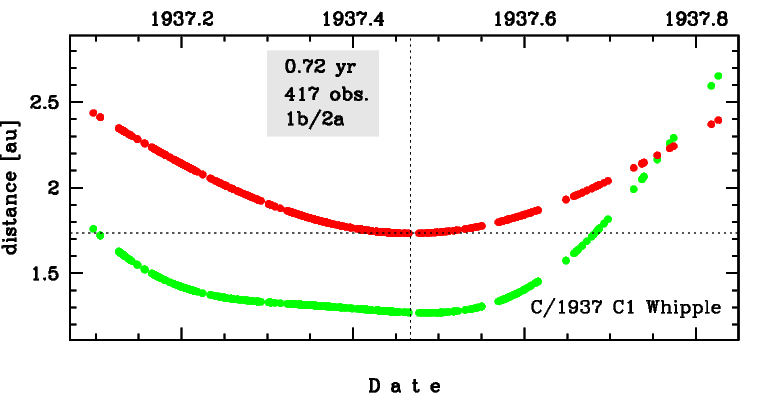C/1937 C1 Whipple
more info
Comet C/1937 C1 was discovered on 7 February 1937 by Fred Lawrence Whipple (Harvard College Observatory, Massachusetts, USA), that is about 4.5 months before its perihelion passage, and the comet was last seen on 28 October 1937.Soon after, Whipple found a prediscovery image on plates exposed on 4 February. [Kronk, Cometography: Volume 4].
This comet made its closest approach to the Earth on 26 June 1937 (1.269 au), that is 6 days after perihelion passage.
Solutions given here are based on data spanning over 0.729 yr in a range of heliocentric distances from 2.44 au through perihelion (1.73 au) to 2.40 au.
Pure gravitational orbit determined from all available positional measurements (417 observations) give 1b-class orbit similarly as in Minor Planet Center (136 obs. used, the same arc of data; 1B-class, see MPC).
It was possible to determine the non-gravitational orbit for C/1937 C1 (preferred orbit); the derived NG solution give very similar original and future 1/a as in the case of pure gravitational model of motion.
This Oort spike comet suffers large planetary perturbations during its passage through the planetary system, and it left the planetary zone on a significantly more tight orbit with the future semimajor axis of about 720 au (see future barycentric orbits in both solutions: pure gravitational and non-gravitational).
More details in Królikowska et al. 2014.
This comet made its closest approach to the Earth on 26 June 1937 (1.269 au), that is 6 days after perihelion passage.
Solutions given here are based on data spanning over 0.729 yr in a range of heliocentric distances from 2.44 au through perihelion (1.73 au) to 2.40 au.
Pure gravitational orbit determined from all available positional measurements (417 observations) give 1b-class orbit similarly as in Minor Planet Center (136 obs. used, the same arc of data; 1B-class, see MPC).
It was possible to determine the non-gravitational orbit for C/1937 C1 (preferred orbit); the derived NG solution give very similar original and future 1/a as in the case of pure gravitational model of motion.
This Oort spike comet suffers large planetary perturbations during its passage through the planetary system, and it left the planetary zone on a significantly more tight orbit with the future semimajor axis of about 720 au (see future barycentric orbits in both solutions: pure gravitational and non-gravitational).
More details in Królikowska et al. 2014.
| solution description | ||
|---|---|---|
| number of observations | 417 | |
| data interval | 1937 02 04 – 1937 10 28 | |
| data type | perihelion within the observation arc (FULL) | |
| data arc selection | entire data set (STD) | |
| range of heliocentric distances | 2.44 au – 1.73 au (perihelion) – 2.4 au | |
| type of model of motion | NS - non-gravitational orbits for standard g(r) | |
| data weighting | YES | |
| number of residuals | 766 | |
| RMS [arcseconds] | 2.48 | |
| orbit quality class | 1b | |
| previous orbit statistics, both Galactic and stellar perturbations were taken into account | ||
|---|---|---|
| no. of returning VCs in the swarm | 4951 | * |
| no. of escaping VCs in the swarm | 50 | |
| no. of hyperbolas among escaping VCs in the swarm | 0 | |
| previous reciprocal semi-major axis [10-6 au-1] | 26.26 – 38.56 – 63.31 | R |
| previous perihelion distance [au] | 0.46 – 160 – 1500 | R |
| previous aphelion distance [103 au] | 32 – 52 – 74 | R |
| time interval to previous perihelion [Myr] | 2 – 3.2 – 6.4 | R |
| percentage of VCs with qprev < 10 | 29 | |
| percentage of VCs with 10 < qprev < 20 | 2 | |
| percentage of VCs with qprev > 20 | 69 | |
| previous_g orbit statistics, here only the Galactic tide has been included | ||
|---|---|---|
| no. of returning VCs in the swarm | 4877 | * |
| no. of escaping VCs in the swarm | 124 | |
| no. of hyperbolas among escaping VCs in the swarm | 3 | |
| previous reciprocal semi-major axis [10-6 au-1] | 27.81 – 45.58 – 63.44 | R |
| previous perihelion distance [au] | 0.046 – 0.65 – 38 | R |
| previous aphelion distance [103 au] | 32 – 44 – 72 | R |
| time interval to previous perihelion [Myr] | 2 – 3.2 – 6.7 | R |
| percentage of VCs with qprev < 10 | 83 | |
| percentage of VCs with 10 < qprev < 20 | 4 | |
| percentage of VCs with qprev > 20 | 13 | |
